中考英语动词分类及训练
中考英语动词分类及训练
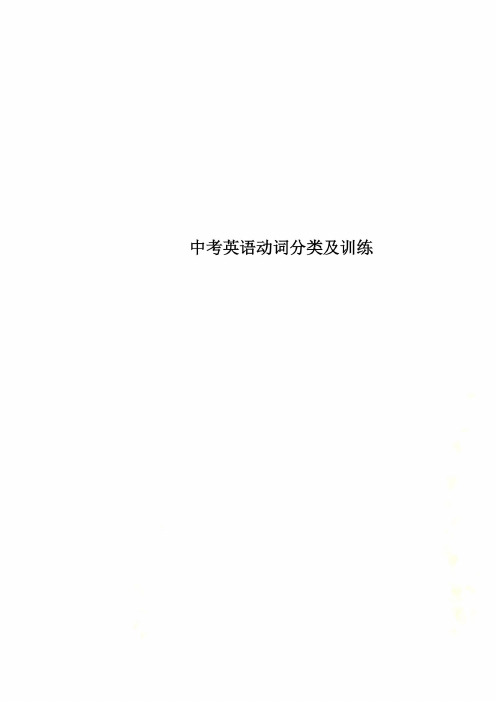
change、drive、play、meet、win、study等。
The girl turned her head and smiled. 这个女孩子转过头笑一笑。
She turned and walked back to the classroom. 她转过身走回教室。
(3)延续性动词延续性动词表示动作是可持续的,如:live, stay, study, work, keep, teach等,可以和时间段连用。
We have lived in China since 2001.You can keep this book for two weeks.(4)非延续性动词非延续性动词表示瞬间动作,如:buy, lend, borrow, die, marry,begin, stop, finish, arrive, join, leave, come, go,catch等,不能和时间段连用。
如果和时间段连用,就要用其他词代替。
He has been here for five days.(arrive)The film has been on for ten minutes.(begin) 常用瞬间动词相应持续性动词关系如下:1、go——be away 2、come——behere3、come back——be back4、leave——be away(be not here)5、buy——have6、borrow——keep7、die——be dead 8、begin——be on9、finish——be over 10、open——be open11、close——be closed 12、lose——be lost 13、get to know——know 14、turn on——be on15、get up——be up 16、sit down——sit/be seated17、join——be in(…)或be a…member18、become——be2. 连系动词连系动词也称为系动词,连系动词有一定词义,但不完整,不能单独做谓语,必须和表语连用,构成系表结构,表示主语身份、性质、状态。
英语中考专项讲解练习:动词1(含答案版)
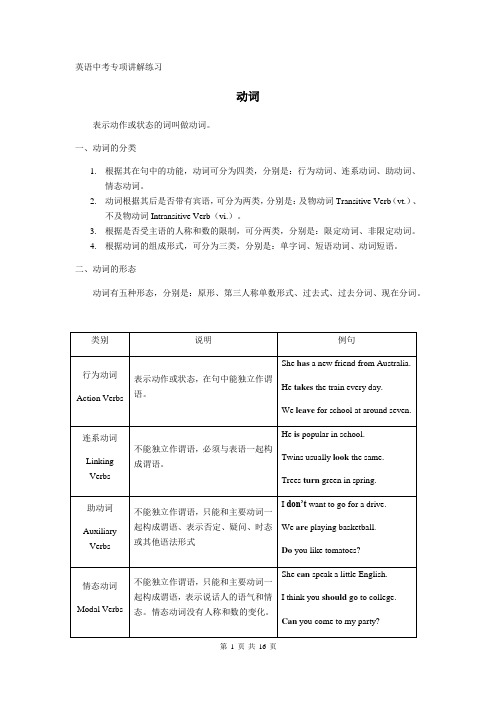
英语中考专项讲解练习动词表示动作或状态的词叫做动词。
一、动词的分类1.根据其在句中的功能,动词可分为四类,分别是:行为动词、连系动词、助动词、情态动词。
2.动词根据其后是否带有宾语,可分为两类,分别是:及物动词Transitive Verb(vt.)、不及物动词Intransitive Verb(vi.)。
3.根据是否受主语的人称和数的限制,可分两类,分别是:限定动词、非限定动词。
4.根据动词的组成形式,可分为三类,分别是:单字词、短语动词、动词短语。
二、动词的形态动词有五种形态,分别是:原形、第三人称单数形式、过去式、过去分词、现在分词。
三、行为动词行为动词又叫实义动词,实义动词意义完全,能独立作谓语。
Mr. Smith gave his wife twenty pounds for her birthday.He asked the teacher a few questions.Children and young people like bright color.He doesn’t like English. (doesn’t是助动词,无词义,like是实义动词)四、系动词系动词又叫联系动词,它本身有词义,但不能单独用作谓语,后面必须跟表语,构成系表结构说明主语的状态、性质、特征等情况。
1.状态系动词用来表示主语状态,只有be一词。
如:He is a teacher (is与补足语一起说明主语的身份)2.持续系动词用来表示主语持续或保持一种状况或态度,主要有keep, rest, remain, stay, lie, stand。
He always keeps silent at meeting.(keep系动词silent表语,系表结构作谓语)This matter rests a mystery.3.表像系动词用来表示"看起来像"这一概念,主要有seem, appear, look。
中考英语动词和动词短语专项解析和考点精练
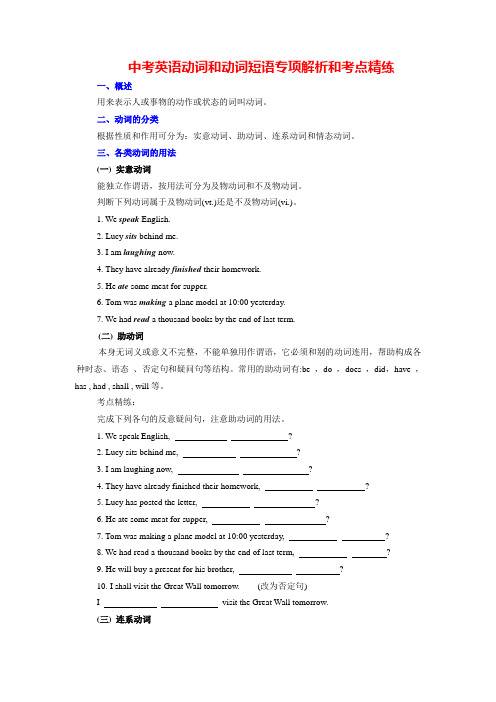
中考英语动词和动词短语专项解析和考点精练一、概述用来表示人或事物的动作或状态的词叫动词。
二、动词的分类根据性质和作用可分为:实意动词、助动词、连系动词和情态动词。
三、各类动词的用法(一) 实意动词能独立作谓语,按用法可分为及物动词和不及物动词。
判断下列动词属于及物动词(vt.)还是不及物动词(vi.)。
1. We speak English.2. Lucy sits behind me.3. I am laughing now.4. They have already finished their homework.5. He ate some meat for supper.6. Tom was making a plane model at 10:00 yesterday.7. We had read a thousand books by the end of last term.(二) 助动词本身无词义或意义不完整,不能单独用作谓语,它必须和别的动词连用,帮助构成各种时态、语态、否定句和疑问句等结构。
常用的助动词有:be ,do ,does ,did,have ,has , had , shall , will等。
考点精练:完成下列各句的反意疑问句,注意助动词的用法。
1. We speak English, ?2. Lucy sits behind me, ?3. I am laughing now, ?4. They have already finished their homework, ?5. Lucy has posted the letter, ?6. He ate some meat for supper, ?7. Tom was making a plane model at 10:00 yesterday, ?8. We had read a thousand books by the end of last term, ?9. He will buy a present for his brother, ?10. I shall visit the Great Wall tomorrow. (改为否定句)I visit the Great Wall tomorrow.(三) 连系动词本身有词义,但不能单独作谓语,必须和表语一起构成谓语,说明主语的状态、性质、特征和身份。
中考英语动词分类讲解及练习(有答案)

中考英语动词分类讲解及练习(有答案)中考英语动词分类讲解及练习(有答案)动词综合讲解⼀、实义动词■①及物动词与不及物动词根据后⾯是否带宾语,⾏为动词⼜可分为及物动词和不及物动词,及物动词。
Vt. vi .They study hard.I know them well.注:有的动词既可作及物动词,也可⽤作不及物动词。
如:She sings very well.She sang an English song just now.英语⾥有不少实义动词可以兼作及物动词和不及物动词Shall I begin at once?She began working as a librarian after she left school.When did they leave Chicago?They left last week.短语:■②动态动词和静态动词动态动词表⽰动作,如give, take, work, run等;静态动词表⽰感觉、情感、内⼼世界、相互关系等,如know, exist, be, have, appear, prove, concern, hate, dislike, like, love, surprise, include, depend on, belong to, guess, suppose,imagine, believe, doubt, admire, envy等。
■③延续性动词和⾮延续性动词根据动作是否延续,⾏为动词⼜分为延续性动词和⾮延续性动词。
如rain, live, work, learn等是延续性动词,go, come, leave, start, arrive, join, finish, end等是⾮延续性动词。
注:⾮延续性动词在肯定句中通常不与表⽰时间段连⽤的for短语连⽤。
如:[译]他离开这⾥三天了。
[误]He has left here for three days.[正]He has been away from here for three days.[正]He left here three days ago.[正]It’s three days since he left.■④限定动词与⾮限定动词限定动词在句中作谓语,有⼈称和数的变化。
初中英语2025届中考动词考点分类讲解练习(实义动词+系动词+助动词+情态动词)

中考英语动词考点分类讲解练习动词是表示动作或状态的词。
动词在句子中充当谓语,用来说明主语是什么或做什么。
一、实义动词实义动词按照其后是否能跟宾语可分为及物动词和不及物动词。
1.及物动词及物动词就是后面必须跟宾语意义才完整的动词。
如love,need,want,have,teach,make等。
I love my mother.我爱我的母亲。
2.不及物动词(1)不及物动词本身意义完整,其后不必跟宾语。
如come,go,run,travel,listen,swim,live,work等。
The man works hard.这个人工作努力。
(2)如果需要带宾语,则不及物动词需要跟适当的介词连用。
Look at the blackboard.看黑板。
3.短语动词l 动词+介词look after照看look for寻找l 动词+副词put up 建立;举起turn on打开l 动词+副词+介词catch up with 赶上do away with 废除l 动词+名词+介词take care of照料;照顾pay attention to注意make use of利用l 动词+名词lose heart失去信心take place 发生【提醒】“动词+副词”形式的短语动词可用作及物或不及物动词。
如果作及物动词,若宾语是名词,可以放在副词之后,也可以放在动词与副词之间。
如果宾语是代词,则必须放在动词与副词之间。
【即学即练】1.—What’s wrong with Simon? He isn’t at school today.—His legs hurt. He was by a motorcycle this morning.A.treatedB.hitC.operatedD.cured2.While traveling in a strange place, you’d better the local people and follow their customs(习俗).A.watchB.changeC.controlD.teach1答案:B2答案:A二、系动词系动词不能单独作谓语,必须与表语一起构成谓语。
英语动词分类讲解及练习(有答案)
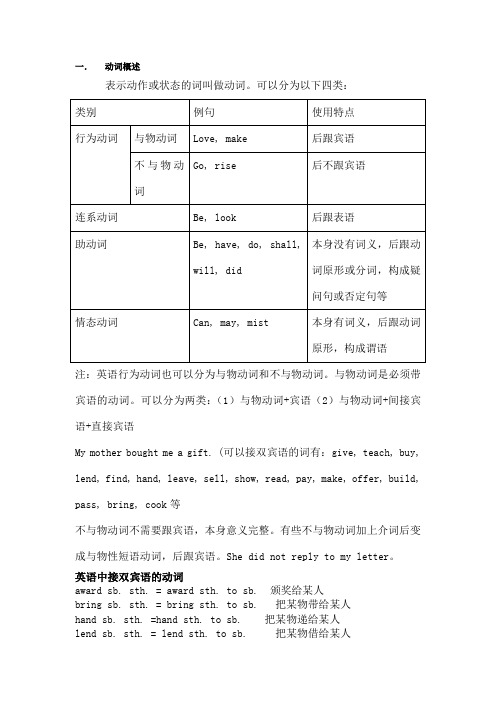
一.动词概述表示动作或状态的词叫做动词。
可以分为以下四类:注:英语行为动词也可以分为与物动词和不与物动词。
与物动词是必须带宾语的动词。
可以分为两类:(1)与物动词+宾语(2)与物动词+间接宾语+直接宾语My mother bought me a gift. (可以接双宾语的词有:give, teach, buy, lend, find, hand, leave, sell, show, read, pay, make, offer, build, pass, bring, cook等不与物动词不需要跟宾语,本身意义完整。
有些不与物动词加上介词后变成与物性短语动词,后跟宾语。
She did not reply to my letter。
英语中接双宾语的动词award sb. sth. = award sth. to sb. 颁奖给某人bring sb. sth. = bring sth. to sb. 把某物带给某人hand sb. sth. =hand sth. to sb. 把某物递给某人lend sb. sth. = lend sth. to sb. 把某物借给某人mail sb. sth. = mail sth. to sb. 把某物寄给某人offer sb. sth. = offer sth. to sb. 将某物给某人owe sb. sth. = owe sth. to sb. 欠某人某物pass sb. sth. = pass sth. to sb. 把某物递给某人pay sb. sth. = pay sth. to sb. 付给某人某物(钱)post sb. sth. = post sth. to sb. 把某物寄给某人read sb. sth. = read sth. to sb. 把某物读给某人听return sb.sth. = return sth. to sb. 把某物还给某人send sb. sth. = send sth. to sb. 把某物送给某人sell sb. sth. = sell sth. to sb. 把某物卖给某人serve sb. sth. = serve sth. to sb. 拿某物招待某人show sb. sth. = show sth. to sb. 拿某物给某人看take sb. sth. = take sth. to sb. 把某物拿给某人teach sb. sth. = teach sth. to sb. 教某人某物tell sb. sth. = tell sth. to sb. 告诉某人某情况throw sb. sth. = throw sth. to sb. 把某物扔给某人write sb. sth. = write sth. to sb. 给某人写信2、双宾语易位时需借助介词for的常用动词book sb. sth. = book sth. for sb. 为某人预定某物buy sb. sth. = buy sth. for sb. 为某人买某物choose sb. sth. = choose sth. for sb. 为某人选某物cook sb. sth. = cook sth. for sb. 为某人煮某物draw sb. sth. = draw sth. for sb. 为某人画某物fetch sb. sth. = fetch sth. for sb. 为某人去取某物find sb. sth. = find sth. for sb. 为某人找到某物fix sb. sth. = fix sth. for sb. 为某人准备某物get sb. sth. = get sth. for sb. 为某人拿来某物make sb. sth. = make sth. for sb. 为某人做某物order sb. sth. = order sth. for sb. 为某人订购某物pick sb. sth. = pick sth. for sb. 为某人采摘某物prepare sb. sth. = prepare sth. for sb. 为某人准备某物save sb. sth. = save sth. for sb. 为某人留某物sing sb. sth. = sing sth. for sb. 为某人唱某物(歌)spare sb. sth. = spare sth. for sb. 为某人让出某物steal sb. sth. = steal sth. for sb. 为某人偷某物3、有的动词后接的双宾语易位时,既可用介词to引出间接宾语,也可用介词for引出间接宾语,含义相同。
中考英语常考动词的分类

中考英语常考动词的分类近几年中考题可以看出动词为单项选择题的必考点,尤其是对动词短语的考查,偏向take、turn、put、down等。
考查形式主要集中在三个方面:①同一动词+不同介词;②不同动词+同一介词;③不同动词+不同介词。
对动词的考查侧重感官系动词词义的辨析,也偶尔涉及实义动词的辨析。
设题形式均为简单句。
一、系动词系动词不能单独作谓语,必须跟表语一起构成谓语(即经常说的系表结构)。
常用的系动词分类如下:(1)be动词:am, is, are, was, were(2)感官类:look, sound, smell, taste, feel(3)变化类:become, get, grow, go, turn(4)状态类:keep, stay二、助动词助动词本身没有词义,不能单独作谓语,只能和其他动词一起构成谓语,表示时态、语态、语气等特征,共同构成否定、疑问、强调、省略等句子。
主要的助动词有be, have,has, had, do, does, did, will, would和shall等。
三、实义动词实义动词是能独立作谓语的动词。
按其语法作用分为及物动词和不及物动词;按其持续性可分为延续性动词和非延续性动词。
1.及物动词及物动词本身意义不完整,需要接宾语才能使其意思完整。
(1)动词+宾语如:Can you open the window?(2)动词+宾语+宾补如:We call him Bill.I saw Tom play in the park yesterday.注意:用省略to的不定式或现在分词作宾补的动词有make, let, see, watch, hear,notice等。
(3)动词+间接宾语+直接宾语如:May I ask you a question?Please pass me the book.常见的带双宾语的动词有:give, bring, buy, get, lend, offer, pass, teach, tell, write,return等。
人教版九年级英语各单元动词总结及练习
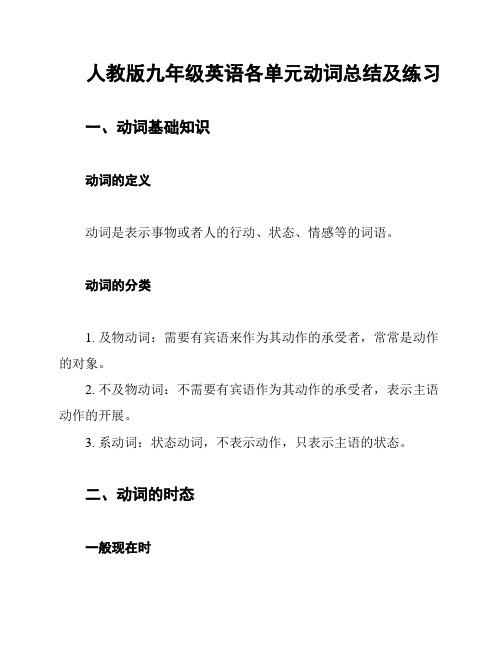
人教版九年级英语各单元动词总结及练习一、动词基础知识动词的定义动词是表示事物或者人的行动、状态、情感等的词语。
动词的分类1. 及物动词:需要有宾语来作为其动作的承受者,常常是动作的对象。
2. 不及物动词:不需要有宾语作为其动作的承受者,表示主语动作的开展。
3. 系动词:状态动词,不表示动作,只表示主语的状态。
二、动词的时态一般现在时表示现在正在进行的动作或者经常性发生的动作。
一般过去时表示发生在过去某个时间的动作,一般和具体时间状语连用。
一般将来时表示将要发生的动作或者存在的状态。
现在进行时表示现在正在进行的动作,通常由 be 动词 + 现在分词构成。
过去进行时表示过去某一时刻正在进行的动作,通常由 be 动词的过去式+ 现在分词构成。
现在完成时表示过去发生的某一件事情对现在造成的影响或者状态,由have/has + 过去分词构成。
过去完成时表示过去某个时间点已经完成的事情,由had + 过去分词构成。
三、动词的语态主动语态表示主语是动作的执行者。
被动语态表示主语是动作的承受者。
四、动词的用法1. 动词不定式动词不定式是由 to + 动词原形构成。
2. 动词-ing 形式动词-ing 形式表示正在进行的动作。
3. 动词的原形动词的原形是指动词的基本形式,通常是由动词词根加上词尾构成。
4. 动词的过去式动词的过去式是指表示过去时间的动作的时态形式,通常是由原形加上-ed 构成。
5. 动词的过去分词动词的过去分词是表示完成或者被动的动作,通常是由have/has + 过去分词构成。
五、动词的练1. I (study) English every day.2. They (play) basketball last weekend.3. He (be) a teacher for 5 years.4. She (not watch) TV yesterday.5. We (finish) our work already.答案:1. study2. played3. has been4. didn't watch5. have finished。
- 1、下载文档前请自行甄别文档内容的完整性,平台不提供额外的编辑、内容补充、找答案等附加服务。
- 2、"仅部分预览"的文档,不可在线预览部分如存在完整性等问题,可反馈申请退款(可完整预览的文档不适用该条件!)。
- 3、如文档侵犯您的权益,请联系客服反馈,我们会尽快为您处理(人工客服工作时间:9:00-18:30)。
中考英语动词分类及训练(总6页)-CAL-FENGHAI.-(YICAI)-Company One1-CAL-本页仅作为文档封面,使用请直接删除动词专项复习一、动词的分类1. 实义动词实义动词时能独立作谓语的动词。
根据动词在句子中是否可以接宾语,可以把实义动词分为及物动词和不及物动词两种类型。
按其持续性可分为延续性动词和非延续性动词。
(1)及物动词及物动词本身意义不完整,需要接宾语才能使其意思完整。
①动词+宾语My brother is flying the kite on the playground.②动词+宾语+宾补The teacher made his students happy by doing some games.We call the bird Polly.注意:省略to的不定式或现在分词作宾补的动词有:make, let,have, see, watch, notice, hear等。
③动词+双宾语My mother gives me a new bike.注意:有些双宾语动词间接宾语(人)放在直接宾语(事物)后时,间接宾语前要加to。
常用的此类词有bring、give、hand、 pass、pay、post、return、sell、show、teach、tell、throw、lend等。
Hand me that book, please. = Hand that book to me, please.有些双宾语动词间接宾语(人)放在直接宾语(事物)后时,间接宾语前要加for。
常用的此类词有buy、choose、cook、draw、book、find、get、make、order等。
My mom bought me a nice backpack. = My mom bought a nice backpack for me.(2)不及物动词不及物动词一般不可以接宾语,但是有些不及物动词与一些介词、副词等词搭配在一起构成短语动词,它的作用等于一个及物动词。
We arrived at the station at five.He turned off the light when he left.He takes pride in doing a job well.注意:有些动词既可作及物动词也可作不及物动词。
常用的此类动词有open、close、 start、change、drive、play、meet、win、study等。
The girl turned her head and smiled. 这个女孩子转过头笑一笑。
She turned and walked back to the classroom. 她转过身走回教室。
(3)延续性动词延续性动词表示动作是可持续的,如:live, stay, study, work, keep, teach等,可以和时间段连用。
We have lived in China since 2001.You can keep this book for two weeks.(4)非延续性动词非延续性动词表示瞬间动作,如:buy, lend, borrow, die, marry,begin, stop, finish, arrive, join, leave, come, go,catch等,不能和时间段连用。
如果和时间段连用,就要用其他词代替。
He has been here for five days.(arrive)The film has been on for ten minutes.(begin)常用瞬间动词相应持续性动词关系如下:1、go——be away2、come——be here3、come back——be back4、leave——be away(be not here)5、buy——have6、borrow——keep7、die——be dead 8、begin——be on9、finish——be over 10、open——be open11、close——be closed 12、lose——be lost13、get to know——know 14、turn on——be on15、get up——be up 16、sit down——sit/be seated17、join——be in(…)或be a…member18、become——be2. 连系动词连系动词也称为系动词,连系动词有一定词义,但不完整,不能单独做谓语,必须和表语连用,构成系表结构,表示主语身份、性质、状态。
You are a teacher, but not a good one.We feel very happy when we know it.英语经常用到的连系动词有:(1) 状态连系动词:表示主语的状态、性质、身份。
(be)My father is very strong.(2) 持续连系动词:表示继续或保持一种状态或情况。
(stay,remain,keep 等)You must keep healthy.(3) 表象连系动词:用来表示“看起来”的这一概念的词。
appear(看起来),seem(看似),look(看起来)。
Your mother looks much younger than I thought.(4) 感官连系动词:feel(摸起来),taste(尝起来),smell(闻起来),sound(听起来)look(看起来)。
The milk tastes a little sour.(5) 转变或结果连系动词:become(变为),get(成为),grow(长得),turn(变得),go(变得)等。
Our village is becoming more and more beautiful.3.助动词助动词本身没有词意,或者意义不完全,不能单独作谓语,只能和别的动词一起在句子中作谓语,帮助动词构成各种时态、语态等及否定、疑问、强调等。
主要的助动词有:be,do,have,shall,will等。
例如:Will you have a sports meeting next week?Is your mother cooking?Don’t be late for class next time.4. 情态动词情态动词一般没有人称和数的变化,在句子中不能单独作谓语,只能和其他动词连用作谓语,表示说话人的语气和情感。
主要的情态动词有:can,may,must,need,would,could,might,dare等。
使用情态动词要注意以下方面:(1) 含must的一般疑问句,肯定回答仍用must,否定回答则用needn’t或don’t have to,表示“不必”。
一般不能用mustn’t,因为mustn’t表示“不可以、禁止”,语气很强。
—Must I finish my homework now?—No, you needn’t.(2) may开头的一般疑问句,肯定回答用may,否定回答用mustn’t。
—May I smoke here?—No, you mustn’t.(3) 表示可能性或推测时,can多用于否定句或疑问句,can’t表示“不可能”;may多用于陈述句,may not表示“可能不”;must只用于肯定句,表示“一定、准是”。
You may be right or may not be right.The news can’t be tr ue.She must be angry.(4) need用作情态动词主要用于否定句、疑问句和条件句,表示“需要”,也可以作实义动词,后跟名词、代词、不定式、动词-ing形式等。
need开头的一般疑问句,肯定回答用must。
You needn’t come if you are busy.—Need I come tomorrow 我明天需要来吗—No, you needn’t. / Yes, you must. 不,没必要。
/ 是的,你必须来。
He needs to get some sleep. 他需要睡一会。
(5) have to的意思接近must,但是must强调说话者的主观意愿。
haveto强调客观上的必要性,常译成“不得不“。
have to可以用于多种时态,其疑问句、否定句都要借助do构成。
Do you have to leave now 你现在必须走了吗You don’t have to get up early. 你没有必要早起。
(6) be able to表示具体的能力,与can用法相近,can只有一般现在时和一般过去时,be able to 可用更多的时态。
was / were able to侧重有能力而且成功地做成了某事,而could只表示过去具备某种能力。
The math problem was hard but I was able to work it out. 这道数学题很难,但我做出来了。
巩固练习1. It is necessary for schools to________ the need of all the students'development.A. cutB. hideC. refuseD. satisfy2.— I don't know where to go this summer vacation.—Why not________ visiting Jingzhou There are many places of interest.A. regardB. considerC. wonderD. suggest3. (These oranges look nice, but________ very sour.A. feelB. tasteC. soundD. look4.—Dad, I'll be in the final singing competition tomorrow.—Be careful not to get a sore throat and________ your voice.A. loseB. raiseD. breaksome countries, people________ download(下载)music from the Internet withoutpaying, because it's against the law.A. wouldn'tB. needn'tC. mustn'tD. couldn't6. — We've ordered too much food. I ________eat any more.—Never mind. Let' take it home.A. can'tB. mustn'tC. needn'tD. shouldn't7. I have travelled a lot. I________ speak four languages.A. canB. mayC. mustD. need8. —________I hand in the report today?— No, you needn't.A. CanB. MustC. ShallD. Could9.—Mum, I've signed for the box. What's in it?—I'm not sure. It________ be a present from your uncle.A. needB. mustC. mayD. will10. We should keep quiet in the cinema. We________ speak loudly.A. canB. mustC. needn'tD. mustn't11. —Have you decided where to spend your holiday?—Not yet. We ________ go to Beijing.A. mayB. mustC. shouldD. need12. —Have you got the results of the exam—No. All we________ do now is to wait.A. mustB. canC. mayD. could13. When you are travelling, bring a map because it________ help you.A. can'tB. mustn'tC. used toD. may14. To keep children safe, we________ put the things like knives and medicineaway in our house.A. mayB. shouldC. canD. might15. —Robert, could you wash the car for me?—Yes, I________. I'm coming, Dad.A. couldB. couldn'tC. canD. can't16. Here is the book. First _________ it and then tell me what you think of it.A. look intoB. look throughC. look upD. look after17. —What kind of persons do you prefer to make friends with?—I choose my friends on their characters and how we __________.A. get inB. get upC. get onD. getoff18. Many teenagers the old and they often offer their seatsto the old on buses.A. agree withB. worry aboutC. laugh atD. care for19 —Show me your homework, Dave?—Sorry, Mrs. Brown. I've it at home.A. missedB. forgottenC. lostD. left20. –How does Jack usually go to work?—He ______ drive a car, but now he ______ there to lose weight.A. used to; is used to walkB. was used to; is used towalkingC. was used to; is used to walkD. used to; is used to walking21. —Can I _______ your bike?—With pleasure. But you mustn’t _______ it to others.A. lend; borrowB. borrow; lendC. lend; lendD. borrow; borrow22. Sometimes the ads _______ but don’t tell you anything about the quality of the product.A. look wellB. sound goodC. taste goodD. seem bad23. ---Look! There is a horse racing program on TV show. ---Hmm….It_______exciting.A. seemsB. looks likeC. soundsD.seems like24. The meat on the plate so delicious. Let's try it together.A. smellsB. soundsC. seesD. feels25. –What’s wrong with the orange--It_______ terrible.A. is tastingB. is tastedC. tastesD. taste26. –I think our chemistry teacher is working hard. He teachesus_______.--Yes, but he hasn’t come today. He doesn’t feel_______.A. good, wellB. good, goodC. well, goodD.well, well。
